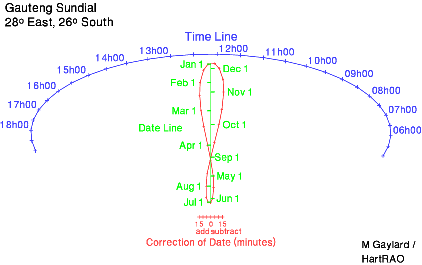
Sundial for Johannesburg / Pretoria, Gauteng Province, South Africa

HartRAO Home > Things to do > Make your own Sundial
The sundial shown below is accurate to within five to ten minutes for places within the province of Gauteng in South Africa, such as Johannesburg or Pretoria. It gives the standard time for southern Africa, which is the time we set on our watches and clocks. (Click on the image for a larger version and data table for making your own):

The green line is called the "date line". The date is estimated by interpolating between the markers on the line. Stand on the green line at today's date, and the shadow falling on the blue line, called the "timeline", gives the mean Sun time. The offset from the green line to the red figure "8" for today gives the correction (described below) to the mean Sun time. The figure "8" shape is known as the "analemma". The size of the correction to be added to or subtracted from the mean Sun time is shown by the scale at the foot of the analemma.
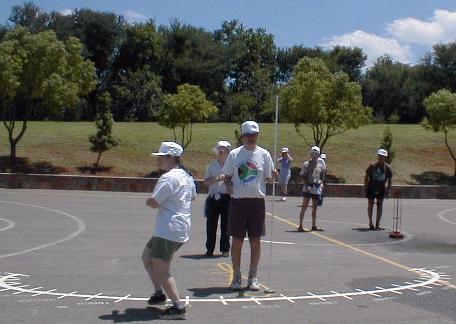
The north-south passage of the Sun during the year is the reason for the north-south extent of the dateline and of the analemma. This apparent motion of the Sun is caused by the Earth's axis being tilted at 23.46 degrees to the plane of its orbit around the Sun. This means that on June 21 the Sun will appear to be almost 47 degrees closer to the northern horizon at midday than on December 21.
There are two reasons why the Sun wanders off to one side and then the other of the dateline, to produce the figure 8:
A sundial is "fast", i.e. ahead of standard time, in May and from September to December. It is about 16 minutes fast at the beginning of November.
A sundial is "slow", i.e. behind standard time, from January to mid-April, and from mid-June to the beginning of August. It is about 14 minutes slow in mid-February.
The picture below shows that the effect is biggest in February and November, and so the loop of the analemma is widest at those times. Sun time matches standard time in mid-April, mid-June, at the beginnning of September, and in late December.
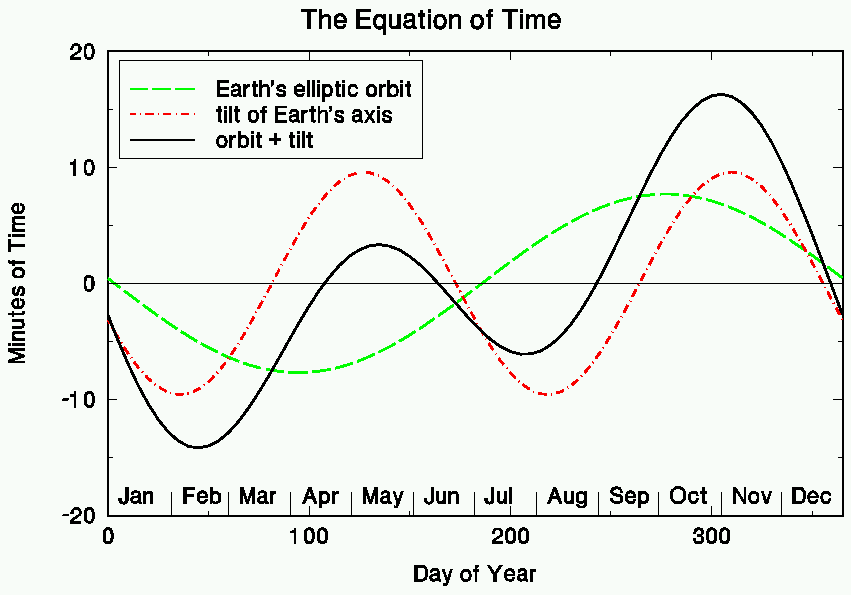
We see the Sun making this figure "8" loop in the sky - these animations show what we see from the southern hemisphere and from the northern hemisphere.
This non-uniform variation in sun time during the year also causes the times of sunrise and sunset to be asymmetric. Graphs of sunrise and sunset for Nairobi, Johannesburg, Durban, Cape Town and SANAE clearly show this effect.
The change in distance from the Earth to the Sun owing to the elliptical orbit is small, up to + or - 1.7% of the mean distance of 150 million km. It is NOT the cause of the seasons. The seasons are a result of the large tilt of the Earth's axis, which causes first the southern hemisphere to be tilted towards the Sun (September to March) and then the northern hemisphere (March to September) as the Earth orbits the Sun. The heating caused by the Sun depends on the sine of its elevation (angle above the horizon), so the closer to the zenith (directly overhead) it passes at midday, the greater the heating. The longer days in summer also let the Sun heat the surface for longer than during the short days in winter.
The effect is much bigger for Cape Town and Windhoek (see below), which are much further west. The opposite effect is seen on the Durban sundial, as Durban is east of 30 degrees longitude, and local time is then ahead of South African Standard Time.
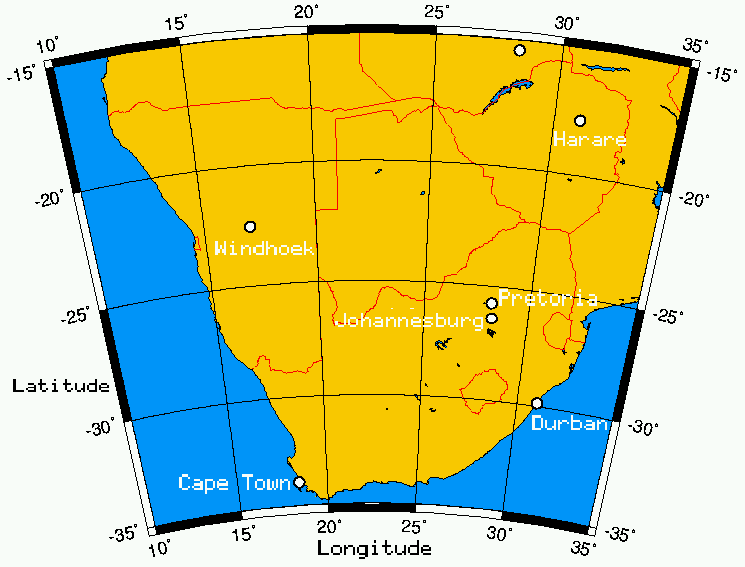
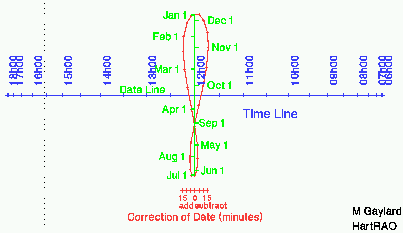
The dateline lies symmetrically across the timeline, because the Sun appears to move an equal distance either side of the equator during the course of the year.
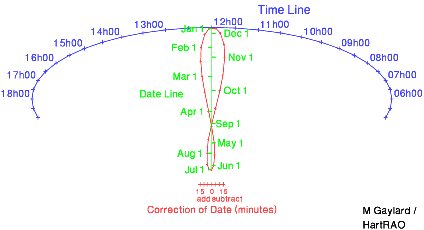
Here the dateline just touches the timeline on which the shadow falls.
Sundial for Bloemfontein, Free State Province,
South Africa
Sundial for Cape Town, Western Cape, South
Africa
Sundial for Dendron, Limpopo
Province, South Africa.
Sundial for Durban, Kwazulu-Natal Province,
South Africa
Sundial for Giyani, in South Africa's
Limpopo / Northern Province.
Sundial for Grahamstown, Eastern Cape, South
Africa.
Sundial for Harare, Zimbabwe.
Sundial for Hermanus, Western Cape, South
Africa
Sundial for Lydenburg, in South Africa's
eastern Mpumulanga Province.
Sundial for Malelane, in South Africa's
north-eastern Mpumulanga Province.
Sundial for Nelspruit, in South Africa's
north-eastern Mpumulanga Province.
Sundial for Pietermaritzburg, in South
Africa's eastern Kwazulu-Natal Province.
Sundial for Polokwane (Pietersburg), in South
Africa's Limpopo Province, lies just south of the tropic of
Capricorn.
Sundial for Potchefstroom, in South Africa's
North-West Province.
Sundial for Richards Bay, Kwazulu-Natal,
South Africa.
Sundial for Sasolburg, Vanderbijlpark and
Vereeniging, Gauteng and Free State, South Africa.
Sundial for Welkom, Free State, South
Africa.
Sundial for Windhoek, Namibia
Design your own horizontal sundial using Jurgen Giesen's "Pie Sundial" Java Applet. Ingeniously, this design has the gnomon built in.
Design your own horizontal sundial at Andrew Reynold's webpage
All you need to know for these is the longitude and latitude of your location, and the longitude of standard time for your time zone. For example Johannesburg is approximately 26 degrees south and 28 degrees, while South African Standard Time is 2 hours earlier than Greenwich, corresponding to an East Longitude of 30 degrees (the Sun moves through 15 degrees in an hour).
Shadows is a free Windows program you can download for designing sundials. The "Expert" and "Pro" versions with more capability are not free.
De Zonnewijzerkring has ZW_Easy and ZW2000 free Windows programs you can download for designing various types of sundials.
Analemmatic sundial mathematics gives you the math behind the sundials shown above.
The Analemma Website has more information on the analemma and equation of time.
Analemmatic Sundials: How to build one and why they work has a simpler explanation about the math.
Sundials on the Internet and The North American Sundial Society provide many general resources and links about sundials.
Sundial links, a page set up by Daniel Roth, has many useful links.
The Sundial Primer by Carl Sabanski has lots of useful information on sundials, descriptions of sundial types, and how to design a sundial.
